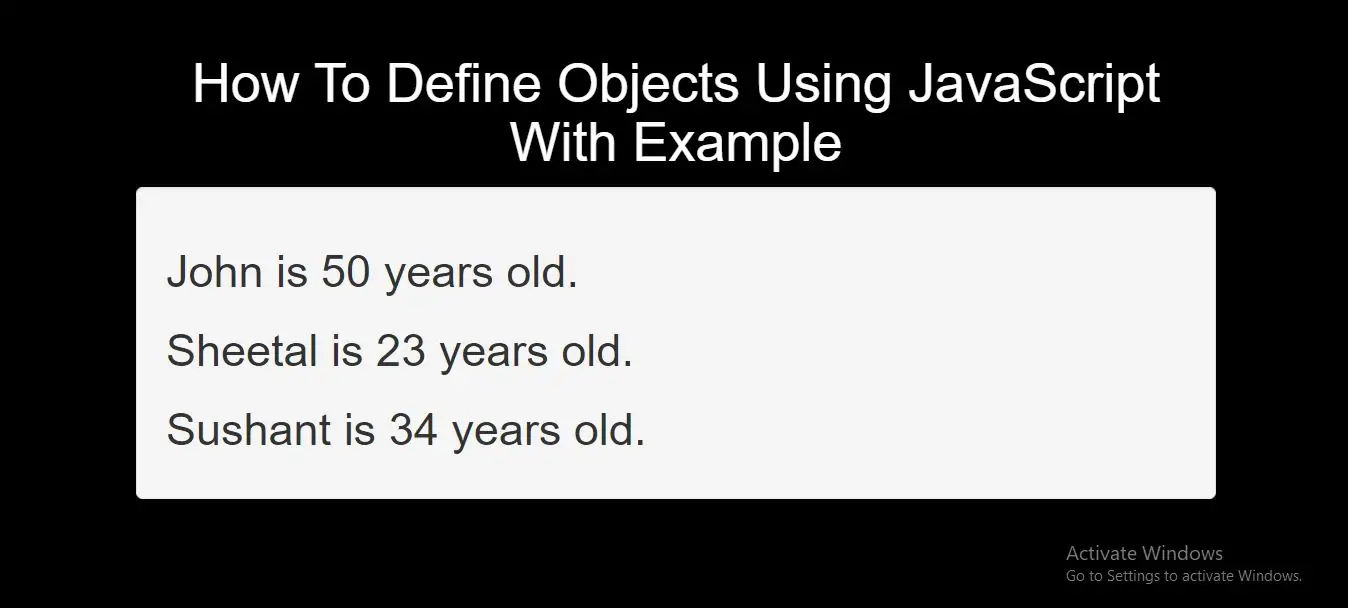
In JavaScript, almost "everything" is an object.
new keyword)new keyword)new keyword)All JavaScript values, except primitives, are objects.
A primitive value is a value that has no properties or methods.
A primitive data type is data that has a primitive value.
JavaScript defines 5 types of primitive data types:
stringnumberbooleannullundefinedPrimitive values are immutable (they are hardcoded and therefore cannot be changed).
if x = 3.14, you can change the value of x. But you cannot change the value of 3.14.
| Value | Type | Comment |
|---|---|---|
| "Hello" | string | "Hello" is always "Hello" |
| 3.14 | number | 3.14 is always 3.14 |
| true | boolean | true is always true |
| false | boolean | false is always false |
| null | null (object) | null is always null |
| undefined | undefined | undefined is always undefined |
Objects are Variables
JavaScript variables can contain single values:
Example(1)
var person = "John Doe";
Objects are variables too. But objects can contain many values.
The values are written as name : value pairs (name and value separated by a colon).
Example(2)
var person = {firstName:"John", lastName:"Doe", age:50, eyeColor:"blue"};
A JavaScript object is a collection of named values
The named values, in JavaScript objects, are called properties.
| Property | Value |
|---|---|
| firstName | John |
| lastName | Doe |
| age | 50 |
| eyeColor | blue |
Objects written as name value pairs are similar to:
Object Methods
Methods are actions that can be performed on objects.
Object properties can be both primitive values, other objects, and functions.
An object method is an object property containing a function definition.
| Property | Value |
|---|---|
| firstName | John |
| lastName | Doe |
| age | 50 |
| eyeColor | blue |
| fullName | function() {return this.firstName + " " + this.lastName;} |
JavaScript objects are containers for named values, called properties and methods.
You will learn more about methods in the next chapters.
Creating a JavaScript Object
With JavaScript, you can define and create your own objects.
There are different ways to create new objects:
new.In ECMAScript 5, an object can also be created with the function Object.create().
Using an Object Literal
This is the easiest way to create a JavaScript Object.
Using an object literal, you both define and create an object in one statement.
An object literal is a list of name:value pairs (like age:50) inside curly braces {}.
The following example creates a new JavaScript object with four properties:
Example(3)
var person = {firstName:"John", lastName:"Doe", age:50, eyeColor:"blue"};
Spaces and line breaks are not important. An object definition can span multiple lines:
Example(4)
var person = {
firstName: "John",
lastName: "Doe",
age: 50,
eyeColor: "blue"
};
Using the JavaScript Keyword new
The following example also creates a new JavaScript object with four properties:
Example(5)
var person = new Object(); person.firstName = "John"; person.lastName = "Doe"; person.age = 50; person.eyeColor = "blue";
The two examples above do exactly the same. There is no need to use new Object().
For simplicity, readability and execution speed, use the first one (the object literal method).
JavaScript Objects are Mutable
Objects are mutable: They are addressed by reference, not by value.
If person is an object, the following statement will not create a copy of person:
Example(6)
var x = person; // This will not create a copy of person.
The object x is not a copy of person. It is person. Both x and person are the same object.
Any changes to x will also change person, because x and person are the same object.
Example(7)
var person = {firstName:"John", lastName:"Doe", age:50, eyeColor:"blue"}
var x = person;
x.age = 10; // This will change both x.age and person.age
Complete Code For Define Objects Using JavaScript
<!DOCTYPE html>
<html>
<head>
<title>How To Define Objects Using JavaScript With Example</title>
<meta charset="utf-8">
<meta name="viewport" content="width=device-width, initial-scale=1">
<link rel="stylesheet" href="https://maxcdn.bootstrapcdn.com/bootstrap/3.4.1/css/bootstrap.min.css">
</head>
<style>
body{
background: black;
}
</style>
<body>
<div class="container">
<br>
<div class="text-center">
<h1 id="color" style="color: White">How To Define Objects Using JavaScript With Example</h1>
</div>
<div class="well">
<h2 id="demo1"></h2>
<h2 id="demo2"></h2>
<h2 id="demo3"></h2>
<script>
var person = {firstName:"John", lastName:"Doe", age:50, eyeColor:"blue"};
document.getElementById("demo1").innerHTML =
person.firstName + " is " + person.age + " years old.";
var women = {
firstName: "Sheetal",
lastName: "Doe",
age: 23,
eyeColor: "brown"
};
document.getElementById("demo2").innerHTML =
women.firstName + " is " + women.age + " years old.";
var man = new Object();
man.firstName = "Sushant";
man.lastName = "Doe";
man.age = 34;
man.eyeColor = "blue";
document.getElementById("demo3").innerHTML =
man.firstName + " is " + man.age + " years old.";
</script>
</div>
</div>
</body>
</html>